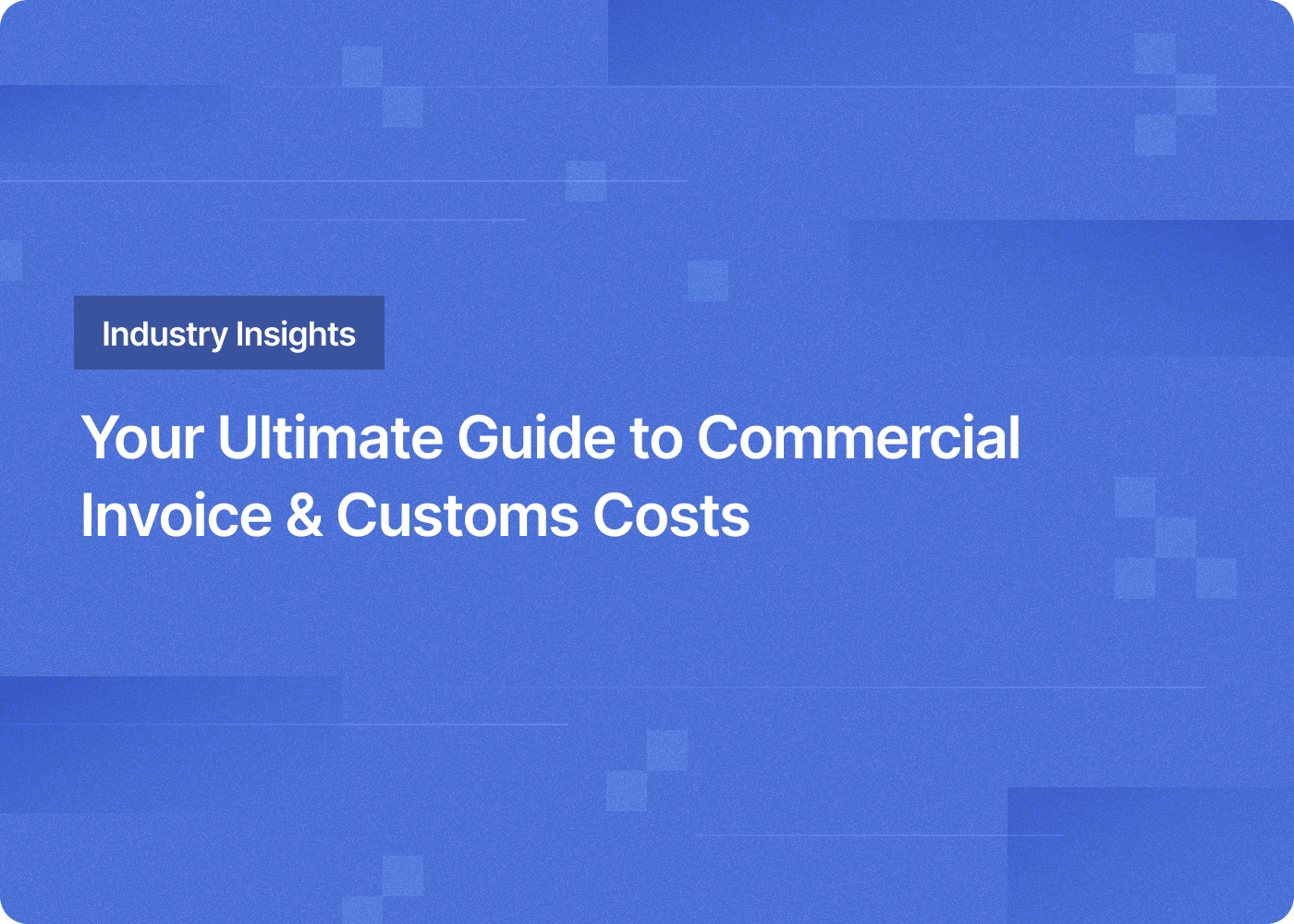Imagine sending an intricately wrapped gift to a friend overseas. The wrapping holds the promise of something valuable inside. Now, consider a commercial invoice as that wrapping paper for international trade. This essential document holds the promise of all the vital details enclosed, ensuring your goods reach their destination seamlessly.
The commercial invoice plays a foundational role in international transactions. At its core, it’s more than just a document detailing product prices or payment terms. Think of it as the DNA of international shipments — encompassing the country of origin, shipment date, HS code, and a plethora of other intricate details. These details are crucial for customs authorities worldwide to determine the customs costs, thereby making the clearance process for your goods straightforward and swift.
Understanding customs costs isn’t just an operational necessity; it’s a strategic game-changer. If you’re dabbling in international trade, not comprehending these costs can lead to unnecessary delays, incorrect duties and taxes, or even legal ramifications. Just like how a tiny misstep in DNA can cause significant implications, overlooking any detail in a commercial invoice can have consequences in the bustling world of international trade.
Whether you’re a seasoned trader or just stepping into the realm of global business transactions, this guide aims to shed light on the intricacies and importance of commercial invoices and customs costs. So, let’s dive deep into this realm and ensure your international shipments remain hassle-free!
Understanding Commercial Invoices: More Than Just a Bill
Often, in the world of business, certain documents may seem mere formalities, just another piece of paper. However, when diving into the labyrinth of international trade, some documents rise in significance. One such document is the commercial invoice.
What does “commercial invoice” mean? Delving into its definition and role
At a glance, the term “commercial invoice” might imply it’s just another bill detailing transactions between a buyer and seller. Yet, its role extends far beyond that simple notion. In essence, a commercial invoice is an essential document in international shipments, acting as a record of the transaction and the parties involved. But more importantly, it’s an official request for payment, making it a cornerstone of trust in international transactions.
The anatomy of commercial invoices: Unveiling the integral components
A commercial invoice isn’t just about numbers or product details; it’s a structured amalgamation of crucial information, designed to provide transparency and clarity. Key components typically include:
Invoice Number: A unique identifier for the transaction.
Buyer and Seller Details: Information about the involved parties.
Description of Goods: A brief description of the items being shipped, often accompanied by the harmonized system code (HS code).
Value of Goods: The total price, which can help in determining customs duties and import duties.
Country of Origin: Where the goods originate, influencing duties and taxes.
Payment Terms: Clarity on delivery and payment terms, ensuring both the buyer and seller are on the same page.
Shipping Details: Details about the shipping company, shipment date, and more.
Each component has a specific purpose, ensuring the commercial invoice serves as both a record and a guide for customs officials, shipping companies, and the parties involved in the transaction.
Commercial Invoice vs Regular Invoice: Spotting the Differences
In the vast realm of international trade and transactions, documentation can often become intricate. Among the myriad of papers and forms, two stand out for their importance: the commercial invoice and the regular invoice. While they may seem similar, their purposes, details, and implications are quite distinct.
The critical distinctions and their implications for international trade
A commercial invoice is primarily used for international shipments, encapsulating essential details about the transaction, country of origin, and duties related information. It’s pivotal for customs clearance and determining the customs costs. Customs officials rely on this document to assess the correct amount of duties and taxes for the shipment.
On the other hand, a regular invoice, often referred to as a pro forma invoice, serves as a preliminary bill of sale, sent to buyers ahead of a shipment or delivery of goods. Its main function is to request payment and detail the goods or services provided.
The role of delivery, payment terms, and unit price in each type
Delivery: In a commercial invoice, the specifics of the international shipment, including shipment date and details about the shipping company, are highlighted. For a regular invoice, it might only mention estimated delivery times.
Payment Terms: Both invoices spell out the payment terms. However, a commercial invoice usually provides more comprehensive delivery and payment terms, especially when dealing with international borders.
Unit Price: The commercial invoice often goes into more detail, including both unit price and total price for the goods, given its role in determining import duties. A regular invoice will mention the unit price and may or may not include details like harmonized system codes.
Understanding these distinctions ensures businesses are well-prepared for the challenges of international trade, avoiding potential legal ramifications or delays.
Commercial Invoices and The Role of Country of Origin
In the intricacies of international shipping, the commercial invoice reigns supreme as one of the most pivotal documents. A crucial element within this invoice is the country of origin, which plays an instrumental role in shaping the customs duties and the overall customs clearance process for international shipments.
How the country of origin influences the commercial invoice and customs duties
The country of origin specified on a commercial invoice determines the tariff rates, import duties, and any applicable trade agreements. This detail impacts the total customs costs a shipment may incur. Customs authorities use this information to calculate duties and taxes, ensuring they align with international trade agreements and standards. For instance, goods coming from EU countries may have different duty rates than those from non-EU countries.
Why this tiny detail carries weight in international shipments
The country of origin not only affects the financial aspects of an international shipment but also has potential legal ramifications. Customs officials and tax authorities scrutinize this detail to prevent fraudulent activities, such as misrepresentation of origin to evade taxes or duties. Properly completed commercial invoices that accurately reflect the country of origin ensure smooth customs clearance and avoid delays, safeguarding both the buyer and seller from unnecessary complications in their business transactions.
Navigating the Terrain of Customs and International Trade
The world of international trade is a vast expanse, brimming with regulations, duties, and intricate processes. Central to this landscape is the role of commercial invoices in guiding a shipment smoothly through the maze of customs clearance. These documents stand as bridges between merchants, customs officials, and the duties imposed by nations.
The dance between commercial invoices and customs clearance
The commercial invoice is a key player in the customs clearance ballet. This document provides customs officers with a clear picture of what’s inside a shipment, its value, and its purpose. By accurately detailing important documents, such as the country of origin, value added tax, and harmonized system code, the commercial invoice ensures that international deliveries pass through customs seamlessly, avoiding delays or potential legal issues.
The symbiotic relationship with customs authorities, officials, and duties
Customs authorities and officials are the gatekeepers of international borders. Their task? Ensuring that goods crossing these borders are legally compliant and that the right amount of duties and taxes are levied. The commercial invoice serves as a dialogue between these authorities and the shipping company. It provides them with the necessary information to determine import duties, detect fraudulent activities, and streamline the customs document processing. This relationship emphasizes the importance of having a correctly filled out and detailed invoice.
How to ensure the correct amount for duties and taxes
Avoiding overpayment or underpayment of duties and taxes begins with an accurate commercial invoice. Businesses must ensure the correct amount is stated on the invoice, taking into account the shipment’s total price, unit price, and any applicable trade agreements. Regular consultations with customs authorities can provide clarity on ever-changing tariff rates and tax rules. Using commercial invoice templates that align with the standards set by the world customs organization can also aid in this endeavor, ensuring every international transaction is compliant and financially sound.
The Glossary: Key Components of Commercial Invoices
Embarking on an international trading journey can often feel like learning a new language. Each commercial invoice comes packed with specific terms that play a vital role in ensuring seamless customs clearance and accurate payment processing. To help you navigate this new linguistic landscape, we’ve curated a concise commercial invoice glossary for those just setting sail.
Deciphering the jargon: A quick commercial invoice glossary for beginners
HS Code (Harmonized System Code): A universal coding system used to classify traded products. It helps customs authorities determine the applicable tariffs and gather global trade statistics.
Buyer and Seller: The two main parties involved in a transaction. The buyer purchases goods, while the seller provides them. Both their details are essential for transparency and accountability.
Invoice Number: A unique number assigned to each commercial invoice, aiding in tracking and ensuring no duplicate payments.
Unit Price: The cost of a single unit of the item being sold. This is crucial for customs officers to ascertain the value of goods and calculate duties.
Gross Weight and Net Weight: Gross weight includes the packaging, while the net weight is just the item. This differentiation helps in determining shipping and handling costs.
Packing List: A detailed list of the contents of a shipment, often accompanying the commercial invoice to provide a comprehensive overview of what’s inside.
The weight and significance of details: From HS code to buyer and seller
Every term on a commercial invoice serves a specific purpose in international trade. For instance, the HS code is more than just a number; it’s a language spoken by customs officials worldwide. Similarly, clearly stating the buyer and seller not only maintains transparency but also facilitates legal ramifications if disputes arise. It’s these small details, when correctly filled out, that ensure shipments move across international borders without a hitch and financial transactions are devoid of discrepancies.
Legal Implications and Customs Costs: Treading with Caution
When dealing with commercial invoices, it’s essential to understand they’re not just a tool for international trade. Their implications stretch far beyond trade, entwining with the intricate web of legal requirements and customs regulations.
Why commercial invoices aren’t just about trade but also legal adherence
Every commercial invoice serves a dual purpose: facilitating trade and ensuring legal adherence. It’s an essential document for customs authorities, allowing them to determine customs duties, verify shipment contents, and ascertain compliance with international laws. Missteps in preparing commercial invoices can result in severe legal ramifications, including fines and shipment delays. Proper understanding and completion of the document safeguard against these issues.
The challenges of international borders and how to ensure smooth customs clearance
Crossing international borders with goods is not always straightforward. Each country has its own set of regulations, which are overseen by customs officials. They meticulously review commercial invoices to ensure that all details align with declared shipment contents and values. A key to smooth customs clearance is ensuring your commercial invoice details are complete and accurate, with no discrepancies.
Additionally, understanding the customs costs, including duties and taxes, is essential. These can significantly vary depending on the country of origin, type of goods, and other factors. Properly completed commercial invoices help in calculating the correct amount, avoiding any unexpected charges or delays in processing.
The dance with customs officials can be intricate, but with a well-prepared commercial invoice in hand, businesses can glide through international borders with greater ease and confidence.
Common Challenges & Solutions in Handling Commercial Invoices
Commercial invoices play a pivotal role in international trade, acting as both a record of sale and a crucial document for customs clearance. However, creating and managing these documents is not without its challenges. Let’s dive into some of the common issues faced and strategies to overcome them.
Navigating pitfalls: From duplicate payments to delay avoidance
Duplicate Payments: One of the recurrent issues is the risk of duplicate payments. This can arise when multiple copies of the same invoice are mistakenly sent to both the buyer and other parties involved. It’s imperative to have a system in place to cross-check and ensure that every commercial invoice corresponds to a unique transaction.
Avoid Delays: Delays can be detrimental, especially when shipping goods across international borders. They often arise from errors in the commercial invoice details or from not meeting the specific requirements of customs officials. Ensuring that all details, from the harmonized system code to the net weight, are correctly filled out is key to delay avoidance.
Strategies for creating and managing commercial invoices effectively
Templates: Utilizing commercial invoice templates can be a lifesaver. They provide a standard format, ensuring that all necessary details are included, which is especially beneficial for businesses frequently engaged in international shipments.
Digital Management: Embrace digital tools and software solutions that allow for easy creation, storage, and retrieval of commercial invoices. This not only streamlines the process but also ensures consistency and accuracy.
Regular Training: Regularly training staff on the latest in international shipping and customs requirements can prevent mistakes and ensure that each commercial invoice is properly completed.
Review Mechanism: Implement a thorough review mechanism. Before any invoice crosses international borders, having a second set of eyes to scrutinize it can help catch any potential errors or omissions.
By acknowledging these challenges and implementing these strategies, businesses can ensure a smoother, more efficient handling of commercial invoices in their international trade endeavors.
Why Mastery Over Commercial Invoices is Essential
In the realm of global business transactions, the commercial invoice stands as a monumental pillar, influencing trade, legal considerations, and relationships between countries. This document is not merely a record of goods sold or a request for payment; it is the heartbeat of international trade, interweaving commerce, customs, and connections across borders.
The delicate balance of international trade is often dependent on the accuracy and completeness of commercial invoices. These documents are intertwined with customs costs, acting as a roadmap for officials to determine duties, taxes, and the legitimacy of goods crossing borders. A slight oversight, an error in detailing the country of origin, or a miscalculation can lead to hefty fines, shipment delays, and reputational damage. It’s more than just paperwork; it’s the currency of trust in global business.
Moreover, as global markets continue to evolve, the harmonious interplay between commercial invoices, customs costs, and fluid trade becomes even more paramount. For businesses aspiring to tap into international markets, achieving mastery over the intricacies of commercial invoices is not just beneficial—it’s essential.
In sum, as global trade continues its upward trajectory, understanding the nuances of commercial invoices and the associated customs costs is indispensable for any business venturing beyond its borders. Embrace the challenge, for in mastering this art, you open doors to opportunities untold.



